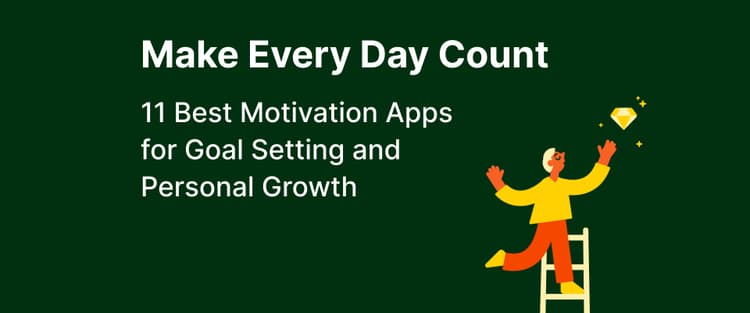Feeling stuck or overwhelmed lately? You're not alone. But it doesn't make you lazy or less creative. Motivation doesn't come and go — this skill stays with you and push you forward. Changing your mindset and creating meaningful habits can help you boost your drive and achieve what matters most to you.
Explore the art of motivation with personal growth experts and psychologists like Mel Robbins, Carol S. Dweck, and Franceso Cirillo whose books offer practical tips and positive affirmations. Many of their best lessons are summarized in the Headway app so you can access key takeaways on the go and revisit them whenever you need a motivational boost.
Consider this your sign to take one small action today. Your productivity, mental well-being, and long-term success are just a few habits away.
In this article, you'll discover:
7 proven strategies to motivate yourself daily — including SMART goals, the 5-second rule, and the Pomodoro Technique
5 common causes of low motivation and how to overcome them
Insights from experts like Mel Robbins, Carol Dweck, and Angela Duckworth
FAQs about motivation and self-discipline
Book summary recommendations from Headway to stay inspired and productive on the go
Top 7 strategies to motivate yourself daily
Struggling with a lack of motivation is a pretty common issue, but that doesn't mean there's nothing you can do about it. With a little know-how, you can kick sluggishness out of the window and be as productive as can be. Let's explore a few methods you can try.

1. Set SMART goals for a clear path forward
Earlier, we talked about the fact that if you don't know what you want to achieve, it's very hard to know where to start. The key is setting SMART goals. This means:
Specific: Define your goal as precisely as possible.
Measurable: Set quantifiable targets to track progress.
Achievable: Ensure that your goal is realistic and attainable.
Relevant: Make sure your goal aligns with your values and aspirations.
Time-bound: Establish a deadline to create urgency and focus.
SMART goals allow you to know exactly what you're trying to do and how to do it. You can also track your progress and change your approach if your strategy doesn't seem to be working. For example, a SMART goal could be saving up a deposit to buy a house. You would define what type of property you want and break down your budget to save enough for a deposit. Then, you keep track of your budget to ensure it’s realistic. The relevant part of the equation would involve regularly assessing your desires. Finally, you create a deadline to achieve your goal.
2. Use the 5-second rule to beat procrastination
Mel Robbins' book, 'The 5 Second Rule: Transform Your Life, Work, and Confidence with Everyday Courage,' provides a simple yet unbelievably effective strategy for getting things done.
It's so easy: when you need to do something, count to five and then move before your brain decides to talk you out of it. It's a way to overcome the tendency to procrastinate and act instead of thinking about it. Robbins tells us that:
"Hesitation is the kiss of death. You might hesitate for a just nanosecond, but that's all it takes. That one small hesitation triggers a mental system that's designed to stop you. And it happens in less than you guessed it — five seconds."
So, get counting and go for it!
3. Change your environment to boost productivity
Your environment plays a significant role in shaping your motivation and productivity levels. By making intentional changes to your surroundings, you can create a space that fuels your energy and focus. Here are some tips for altering your environment to stay motivated:
Declutter your workspace to minimize distractions and enhance concentration.
Personalize your environment with motivational quotes, images, or objects that inspire you.
Create a designated work area that is separate from spaces associated with relaxation or leisure.
Experiment with different lighting, colors, and organization systems to optimize your productivity.
4. Track your progress and celebrate small wins

Monitor your progress to set big goals. By tracking your achievements and celebrating milestones, you can reinforce positive behaviors and build momentum.
You see, motivation is all about mindset. The way we think affects what we do. In fact, Carol S. Dweck illustrates this perfectly in her book, 'Mindset: The New Psychology of Success.' She states that children have a much more positive attitude toward failure than adults. They see problems as learning opportunities. However, adults tend to dwell on them, allowing the experience to push them into inaction.
It's a good idea to keep a journal or digital tracker to record your daily accomplishments and challenges. You could also set up visual cues like progress charts or checklists to visualize your journey. And don't forget to reward yourself for reaching specific milestones with meaningful incentives or treats.
5. Eliminate distractions and stay focused

When it comes to self-improvement and self-motivation, distractions can derail your focus and drain your motivation day to day. To stay on track and productive, it is essential to identify and minimize potential interruptions in your environment. Here are some strategies for eliminating distractions:
Create a distraction-free zone by turning off notifications, closing unnecessary tabs, and setting boundaries with others.
Implement time-blocking techniques to allocate specific periods for focused work without interruptions.
Use productivity tools like website blockers or apps to limit access to distracting sites or social media platforms.
Practice mindfulness to cultivate present-moment awareness and reduce the impact of external distractions on your concentration. That way, you're less likely to lose motivation.
6. Practice mindfulness and meditation for mental clarity

Mindfulness is the practice of being fully present in the moment, while meditation involves focused attention and relaxation. Both techniques can help reduce stress, increase self-awareness, and boost motivation.
Many people think that these two practices are just too hard, but it's simply because they've never taken the time to try. You can improve focus and concentration by practicing mindfulness exercises like deep breathing or body scans. You can also cultivate self-compassion and emotional resilience through regular meditation sessions. Additionally, you can enhance decision-making skills and creativity by training your mind to remain calm and centered in challenging situations.
Look online for some meditation exercises or simply train your mind to focus on the here and now. You could even find podcasts with guided meditations and affirmations. It will take time and effort, but the rewards are worth it.
7. Try the Pomodoro Technique for better focus
Behavioral practices focus on cultivating positive habits and routines that support your motivation and productivity. They are often small things that have a huge impact, even in the short-term. One popular technique is the Pomodoro Technique which involves working in short, focused intervals followed by brief breaks. In his book, ‘The Pomodoro Technique,’ Franceso Cirillo explains that without an outline to your work, "The timetable is protracted, fatigue increases, productivity drops, and the timetable again is protracted."
Here's how you can use the Pomodoro Technique in your day to day work:
Set a timer for 25 minutes of focused work, followed by a 5-minute short break, to maximize productivity.
Repeat the Pomodoro cycles throughout your workday to maintain high levels of concentration and mental energy.
Reflect on your accomplishments and challenges at the end of each work session to adjust your strategy and stay motivated.
Experiment with variations of the Pomodoro Technique, such as longer work intervals or alternating tasks, to find what works best for you.
What causes low motivation and how to overcome it?
What causes your lack of motivation? There are a million and one reasons why you might struggle to get started on your to-do list, but it's important to identify the areas that you struggle with. To help you do that, let's look at some of the most common obstacles to motivation and process.
Lack of clear goals: If you don't clearly define measurable goals, it's like trying to navigate a bustling crowd in a blindfold. When that happens, staying motivated is very challenging. Carol Dweck explains that you either have a fixed or growth mindset. If you're fixed, you assess your value and ability on what you've achieved. If you're growth, you see everything as a learning opportunity. So, if you have a fixed mindset, you might find it harder to get started because you automatically assume you won't do well: "No matter what your ability is, effort is what ignites that ability and turns it into accomplishment." Basically, if you don't try, you won't get it.
Fear of failure: The fear of not succeeding or making mistakes can hinder motivation. It is important to remember that failure is a natural part of the learning process and should be viewed as an opportunity for growth and improvement. And if you fail, so what? You can just try again.
Negative self-talk: Negative thoughts and self-doubt can be major obstacles to staying motivated. It is important to practice self-compassion and challenge negative beliefs to cultivate a more positive mindset.
Lack of support: A lack of encouragement or support from family members and friends can make it difficult to stay motivated. Surrounding yourself with positive and supportive people who believe in your abilities, however, can help boost motivation.
Burnout: Overworking or overwhelming yourself with too many tasks can lead to burnout, which can drain motivation. It is important to prioritize self-care, take breaks, and set realistic boundaries to prevent burnout and maintain intrinsic motivation. It’s vitally important for your mental health.
Ask the experts: How to unlock your potential
Most of us believe that our dreams should remain in the back of our minds, something to keep us warm on a cold day. But why not go after your dreams? Who says you can't achieve them?
David Goggins on comfort zone and its dangers
Again, it all comes down to motivation.
In David Goggins’ book, 'Can’t Hurt Me: Master Your Mind and Defy the Odds,' we learn that we're so used to staying in our comfort zone we sabotage our ability to achieve our dreams. We simply don’t test our potential; in fact, we only use 40% of our natural abilities, with the other 60% sitting idle.
"You are in danger of living a life so comfortable and soft, that you will die without ever realizing your true potential." — David Goggins
It's a scary thought, isn't it? Well, in a single day, you can get started. Write down your dreams and stick them on your bathroom mirror. Work out the first step, the one after that, and keep going. Make a separate sticky note for each step, and every time you achieve one, rip it off the mirror and throw it in the bin. Every removed note will motivate you to take another step. Because, in the end, get up, it's on you: "No one is going to come help you. No one's coming to save you," Goggins tells us.
Angela Duckworth on missed opportunities and grit
Another potential stumbling block is the belief that some people are just born able to fulfill their desires and others aren't.
It's a fallacy, as Angela Duckworth tells us in her book, 'Grit: The Power of Passion and Perseverance.' We feel that setting goals is a strategy for the elite, but it's within us all. Those who achieve simply see opportunities everywhere, whereas those who don't believe talk themselves out of it. Perhaps you should start speaking to yourself as you would your best friend.
"Our potential is one thing. What we do with it is quite another." — Angela Duckworth.
Boost your self-motivation with Headway book summaries
Sometimes, all you need is a gentle nudge in the right direction. It's easy to sit and think that success and joy aren't meant for you, but it's there for all of us. You just need to take control, set goals, and go for it. Headway's library of non-fiction books on motivation and self-growth will certainly give you the boost of motivation you need. Draw wisdom from 'Secrets of the Millionaire Mind' by T. Harv Eker, 'The Miracle Morning' by Hal Elrod, and other titles to built a positive mindset.
From time management, stress management, and confidence building to career advice and personal development, Headway has you covered. In just 15 minutes, you can read or listen to book summaries and discover inspiring insights to help you grow on the go.
And who knows, maybe with a little courage and a boost of confidence, you could achieve those big dreams you've always had in the back of your mind. After all, If you can dream it, you can achieve it. Work hard and see yourself soar!
Frequently Asked Questions
What is motivation?
Motivation fuels your actions and goals. It drives you to work toward achieving your dreams and aspirations. It also gives you the spark that keeps you moving forward, even in the face of life challenges. Understanding what motivates you can help you stay focused, dedicated, and enthusiastic about your goals.
What is the best way to motivate yourself?
Discovering what motivates you is deeply personal and can be influenced by your values, beliefs, experiences, and goals. Some people are motivated by external factors such as recognition, rewards, or competition, while others are driven by intrinsic factors like personal growth, passion, or a sense of purpose.
Is self-motivated a skill?
Motivation is an skill important because it gives you a sense of purpose and direction in life. When you are motivated, you are more likely to set meaningful goals, work toward them with determination, and ultimately experience a sense of fulfillment when you achieve them.
Why do I struggle to motivate myself?
Modern life can be overwhelming, especially if you’re stuck in your work-life routine. Visiting the same places and doing the same job over and over again numb your senses and emotions. Lack of nutrients, vitamins, and dehydration can also cause fatigue and physical exhaustion.
How do I inspire myself?
Try out different hobbies to feel the burst of inspiration and creativity. Reading new books and visiting places you’ve never been before can also make life more interesting and fascinating. Experiment with your living space — try to renovate your work desk or declutter wardrobe to minimize distractions and surround yourself with meaningful objects only.







